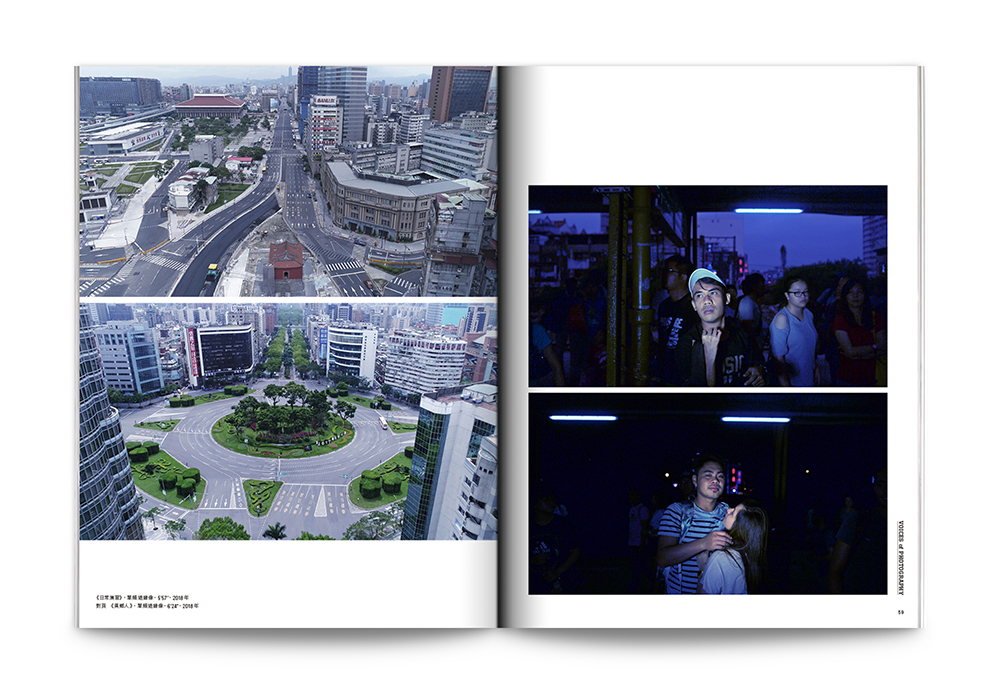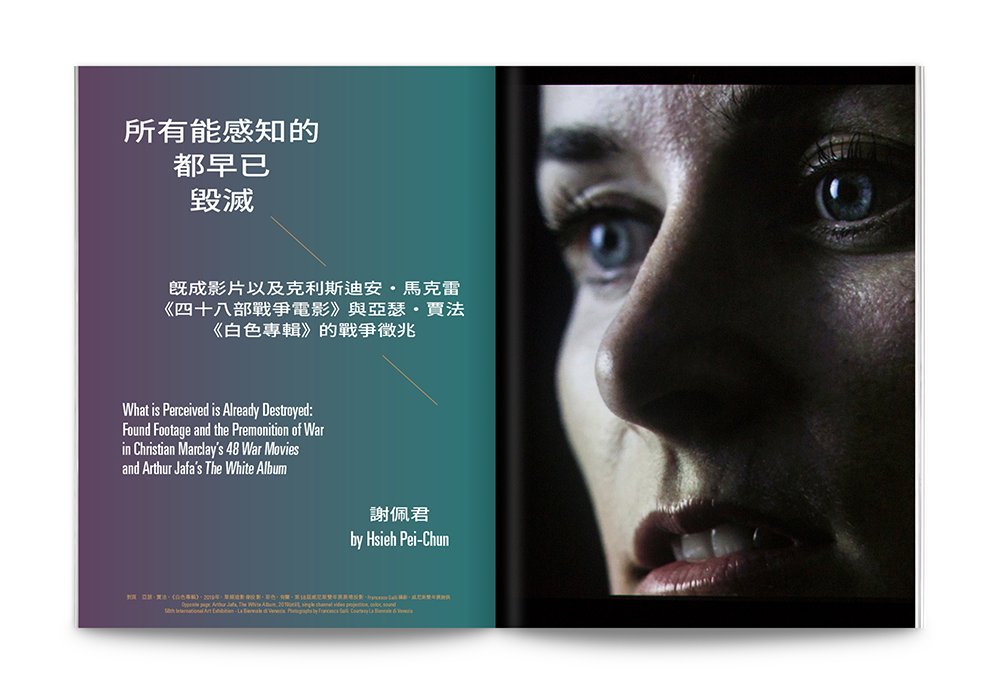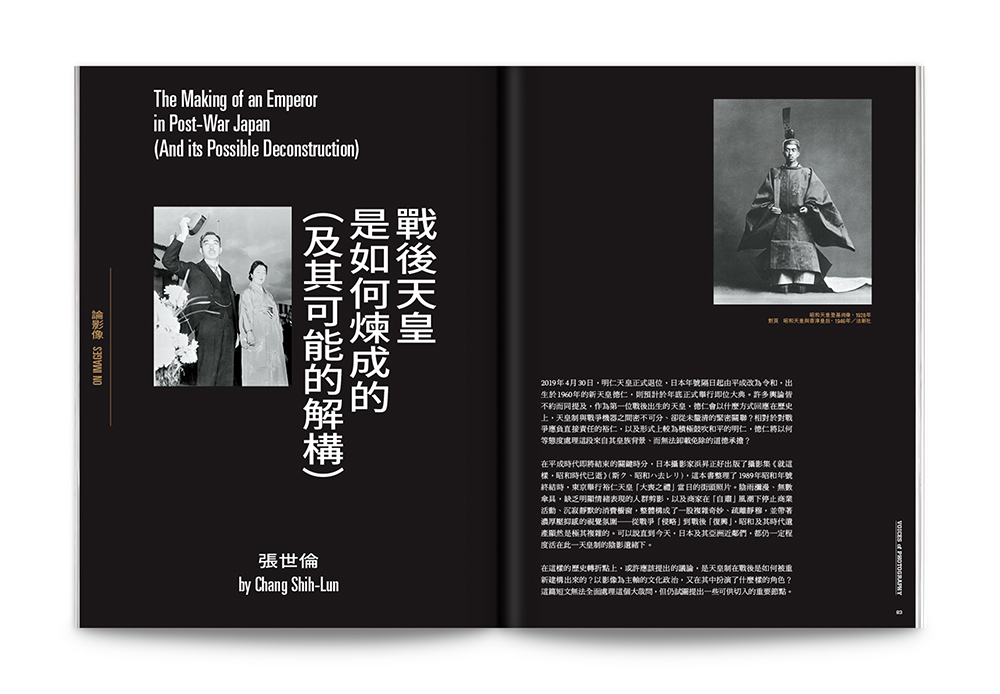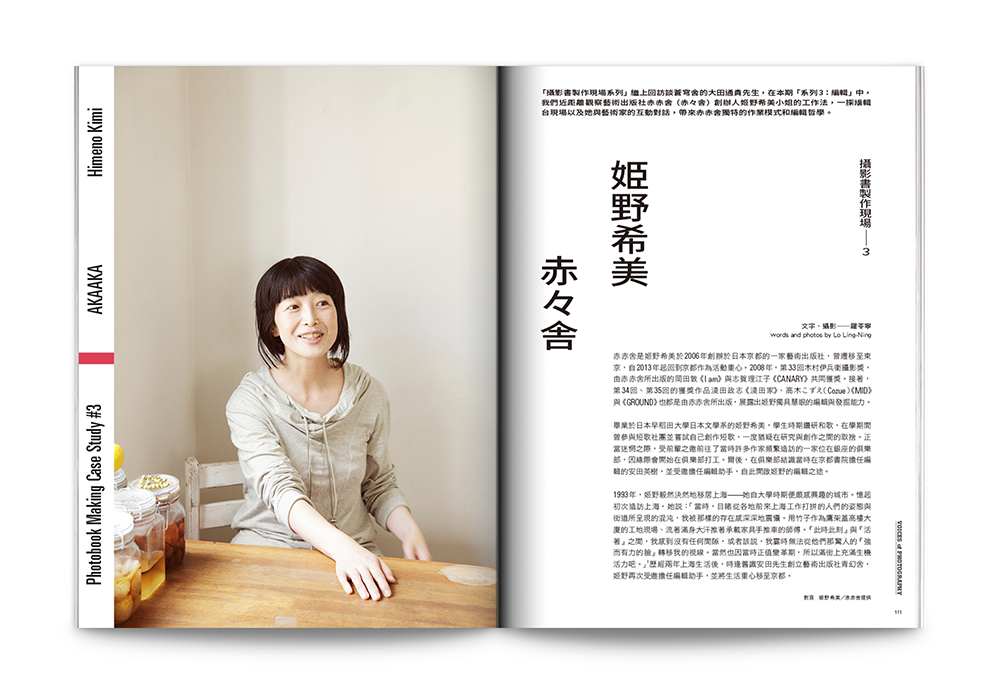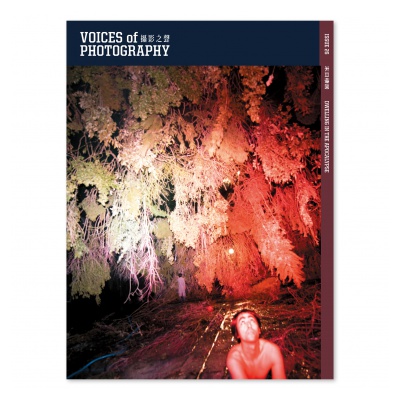
Voices of Photography 攝影之聲
Issue 26 : 末日棲居
Dwelling in the Apocalypse
面對不可預期的來日,我們是否與德國詩人腓特烈.賀德林(Friedrich Hölderlin)曾言的「詩意地棲居」更加疏遠?災害與戰禍、虛假與算計,人類世界無限擴張的野心和欲望未曾降低,人的存在也愈來愈難以賦添詩意。而衝突升高的國際政治情勢,使此刻相隔末日只剩兩分鐘的「末日時鐘」竟回到與1953年冷戰時期的同一等級,成為二戰結束以來與末日距離最近的年代。我們如何可能地棲居——在末日到來的大地?
志賀理江子迷離如夢般的影像書寫,是她在2011年親歷東日本大地震之後對於存在與死亡的感知路徑。在新作《Human Spring》中,志賀試圖打開如今已逐漸被封閉但仍存於人類內在的自然性與身體感,透過繪織意識流般的圖景,呈現著對於人性與生存本身的冥思啟示。林諭志的《Asongcalledformosa》是他在漫長的家園行旅中刻錄的私房曲盤—故鄉與里人、工業區和荒涼的海岸、父親在二戰時遭日本軍徵召至南洋服役的往事記憶⋯⋯,跨越數十年的影像在此首次發表,島嶼的戀曲與哀歌幽幽鳴奏,旅人一路踽踽低吟。1980年代起投入錄像裝置創作的袁廣鳴,作品反映著對於日常生活的不安覺察,自上世紀末的《關於米勒的晚禱》、《離位》到本世紀的《城市失格》、《能量的風景》、《棲居如詩》、《日常演習》等系列作品,發散著前末日感氣息的寓言,這些寓言緩慢漂移在去人化的現代社會空間,直至世界轟然炸裂。
在本期中,謝佩君深度描寫美國藝術家克利斯迪安.馬克雷(Christian Marclay)與亞瑟.賈法(Arthur Jafa)各自運用現成影像蒙太奇的創作,傳遞著影像生產中戰爭、暴力的末世預警,這兩件於今年威尼斯雙年展中受到矚目的錄像作品,同時反映著本屆「願你生活在有趣的時代」這個對現今世界充滿各種不確定性的喻義主題。陳儒修則從影史開展的歷史性一幕—「火車進站」—指出電影發展的開端與災難的關聯、災難電影與現實經驗的糾葛,以及電影本身所造成的歷史性災難。
日本在今年告別「平成」年代並開啟「令和」年號,對日本的政治與文化進入新的階段有著重要的象徵意義,張世倫從昭和天皇裕仁於1946年發表的「人間宣言」開始,針對天皇形象在戰後的轉變與影像包裝歷程,進行了細緻地視覺解析,檢視天皇制度綿延而生的歷史記憶與文化政治。「攝影書製作現場」單元則近訪日本藝術書籍出版社赤赤舍創辦人姬野希美,記錄了外界少見的編印工作實況。
今年三月起,《攝影之聲》與空總台灣當代文化實驗場合作舉辦了一系列由藝術家和影像研究者帶領的「歷史後像:攝影史敘事工作坊」,嘗試推進攝影史的當代意義與創造性思索。本期我們特別摘錄其中由高重黎主持的「影像機器工作坊」談話,在這份講稿中,他以視覺原理出發,揭示藝術與文學創作如何回應攝影與視覺,並創造出強調手眼協作感知的「觸/視頭部造相術」,為思考攝影/視覺史帶來新的啟發。關於工作坊系列的更多內容,我們將在後續製作的專題中呈現。同時,我們近期也將舉辦攝影史論壇與相關活動,等待你一起來參與。
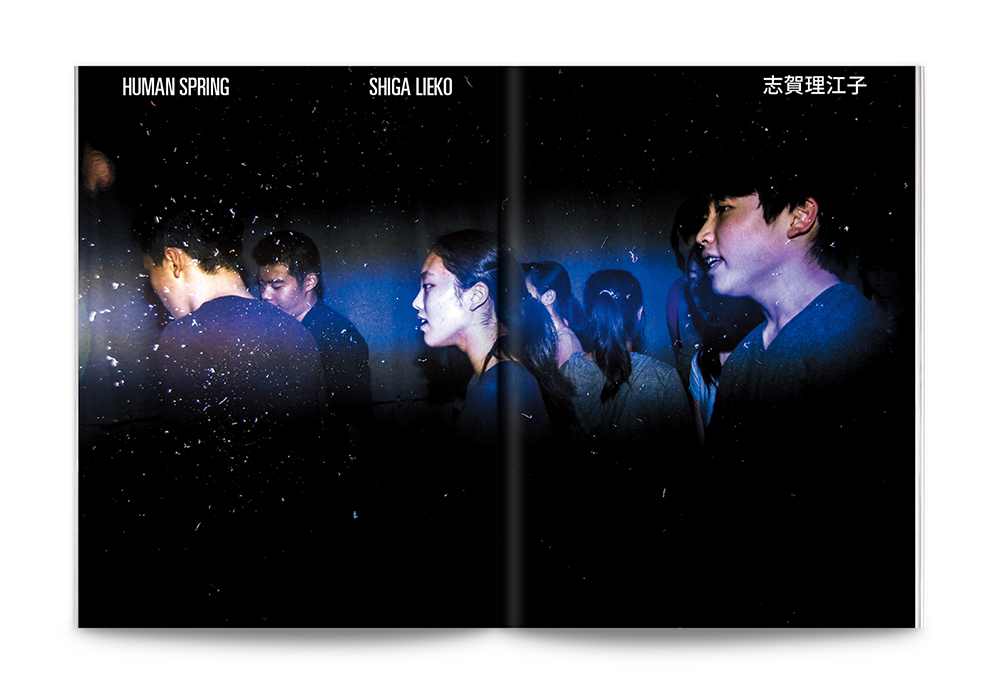
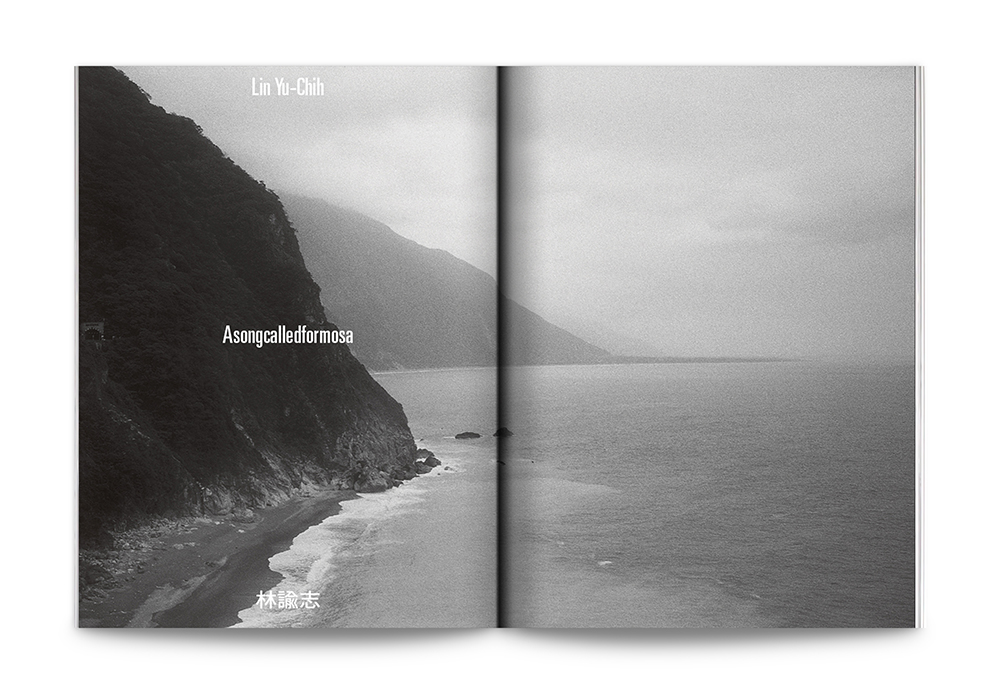
In the face of unpredictable days ahead, have we drifted even further away from the “poetic dwelling” the German poet Friedrich Hölderlin so poignantly described? Disasters and wars, lies and scheming - the ambitions and desires that plague the human world never cease to expand, making it harder to imbue the presence of humans with a sense of poetry. As the threat of conflict in global politics rises to its highest level since the Cold War in 1953, where the “doomsday clock” stays at two minutes to midnight, we are closer than ever to the end since World War II. How do we possibly survive on this land as the apocalypse closes in?
Shiga Lieko’s dream-like imagery creations reflect her perception of life and death after living through the Great East Japan Earthquake in 2011. In her latest work, Human Spring, Shiga attempts to recover the sense of nature and self that lies within all humans but has since been forgotten and buried. She does so through the use of imagery that flows like a stream of consciousness, presenting a picture of meditation on human nature and survival itself. Lin Yu-Chih’s Asongcalledformosa is a private songbook he created on a long travel home, filled with songs like that of his hometown and its people, the industrial area and the desolate coast, and memories of his father being recruited by the Japanese army to serve in Southeast Asia. These images taken over the course of decades are published for the first time, singing the love and sorrowful songs of this island that the traveler hums along to as he set out on his journey. Yuan Goang-Ming has been working with video installation since the 1980s, and his work illustrates a sense of uneasiness towards daily life. From About Millet’s The Angelus and Out of Position created at the end of last century, to more recent works such as City Disqualified, Landscape of Energy, Dwelling and Everyday Maneuver, a sense of our past and last days permeates his creations, the message of which is drifting afloat in the modern social space that has been dehumanized, until the world can finally take no more.
In this issue, Hsieh Pei-Chun describes in great detail American artists Christian Marclay and Arthur Jafa’s works that consist of found footage, and are warning of war and violence. Their works received much attention in this year’s edition of the Venice Biennale as they reflected the metaphorical theme of the Biennale that hints at uncertainties in today’s world, “May You Live in Interesting Times”. On the other hand, Chen Ru-Shou draws a connection between movies and disasters, the entanglement of disaster films and real-life experience and finally the disasters brought about by filmmaking itself.
Japan’s era name change from Heisei to Reiwa this year is symbolically significant both for her politics as well as her culture which have also entered a new era. Chang Shih-Lun takes a look at the post-war transformation in the external images of Emperor Hirohito since his “Declaration of Humanity” in 1946, analyzing in detail the memories of history and cultural politics that followed Japan’s imperial system. Furthermore, the Photobook Making Case Study segment features a rare behind-the-scenes look at printing work with Himeno Kimi, founder of AKAAKA, a Japanese art book publisher.
Since March this year, we have been co-organizing with C-LAB the Afterimage of History: Photography History Narrative Workshops, a series of workshops led by artists and imagery researchers, promoting the critical thinking of contemporary meaning and creativity in the history of photography. In this issue, we are featuring an excerpt from artist Kao Chung-Li’s lecture in his Imagery Machine workshop, in which he spoke about the principles of visual imagery, and revealed the ways art and literary creations responded to photography and visual perception. (Kao also created a concept called “chù/shìh tóu bù jhào siàng shù” (tangibility of touch/sight head phase-image making method), a method to illustrate the perception of touch and sight in image creation, inspiring new ways to approach photography and visual history.) We will be featuring more content from the workshops in future issues. At the same time, we will also be organizing a forum on photography history, and we look forward to your participation.
